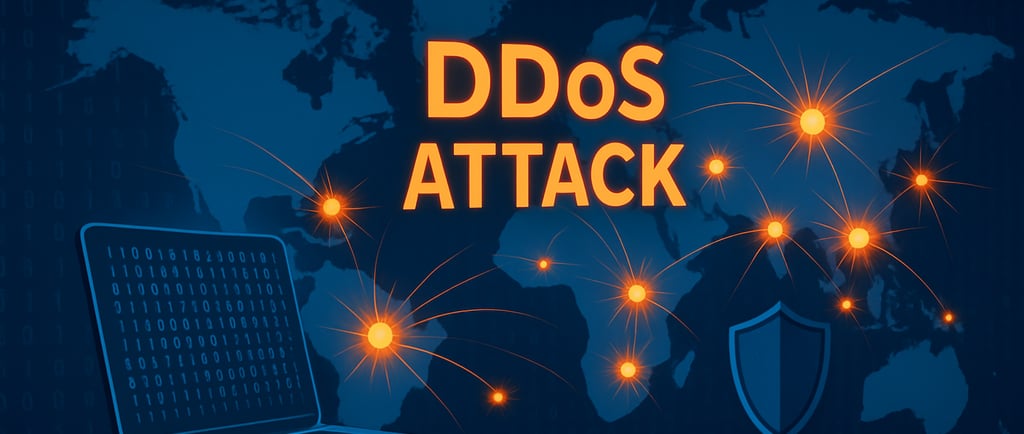
The 2025 DDoS Attack Surge
What's Happening and Why it Matters
Shane Brown
4/29/20254 min read


The 2025 DDoS Attack Surge: What's Happening and Why It Matters
The first quarter of 2025 has seen an unprecedented surge in Distributed Denial of Service (DDoS) attacks, setting new records in both frequency and scale. This wave is reshaping the cybersecurity landscape, impacting businesses, critical infrastructure, and entire regions.
Unprecedented Growth by the Numbers
Cloudflare alone blocked 20.5 million DDoS attacks in Q1 2025—a 358% year-over-year (YoY) increase and nearly as many as the total attacks it mitigated in all of 2024[1][2].
Network-layer DDoS attacks saw the sharpest spike, with 16.8 million incidents (a 509% YoY jump)[1][2].
Over 700 "hyper-volumetric" attacks—each exceeding 1 terabit per second (Tbps) or 1 billion packets per second (Bpps)—were recorded in just three months, averaging eight such attacks per day[1][2].
The largest attacks peaked at 6.5 Tbps and 4.8 Bpps, shattering previous records and demonstrating the sheer destructive potential now at play[1][11].
In 2024, DDoS attacks increased by 13% in the first two quarters alone, with more than 8 million incidents recorded[3].
Evolving Tactics and Attack Vectors
Modern DDoS campaigns are no longer isolated or simplistic. Attackers now:
Use multi-vector approaches, combining volumetric floods, protocol abuse (such as SYN, UDP, and SSDP amplification), and application-layer attacks to probe and overwhelm defenses[1][2][3].
Leverage new vectors like CLDAP and ESP reflection/amplification, which saw 3,488% and 2,301% quarter-over-quarter increases, respectively[2].
Employ automation and botnets built from compromised IoT devices and virtual machines, making attacks more powerful and harder to trace[4][11].
Target not just websites, but APIs, DNS infrastructure, and backend systems, broadening the attack surface[3][4].
Utilize AI to enhance attack capabilities, with threat actors employing artificial intelligence to automate reconnaissance and adapt attack strategies in real-time[6].
Who and What Are the Targets?
Telecommunications, finance, healthcare, and government sectors are bearing the brunt of these attacks, with telecoms seeing a 548% rise in application-layer DDoS incidents[5][20].
The financial sector remains a prime target, with politically motivated hacktivists and advanced botnets driving the surge[11].
Major sporting events, elections, and periods of geopolitical tension often trigger large-scale attacks, as seen with recent strikes on online betting platforms during high-profile NHL games[13][15].
Attackers range from competitors and disgruntled users to state-sponsored and ideologically motivated groups, with hacktivism on the rise[1][5][20].
Retailers are experiencing a 60% increase in bot-driven attacks, aimed at exploiting vulnerabilities in e-commerce platforms[10].
Why the Surge? Key Drivers
Commoditization of Cybercrime: DDoS-for-hire services ("booters" or "stressers") make launching attacks cheap and accessible to anyone, regardless of technical skill[3][12].
Geopolitical Tensions: Nation-state actors and hacktivist groups increasingly use DDoS as a tool of disruption during elections, protests, and international conflicts[4][13][20].
Botnet Evolution: The proliferation of insecure IoT devices and the use of cloud-based virtual machines have created massive, globally distributed botnets capable of overwhelming even robust infrastructures[4][11].
Advances in Attack Techniques: New methods like HTTP/2 Rapid Reset and business logic exploitation are designed to bypass traditional defenses and blend in with legitimate traffic[4][12].
AI-Enhanced Capabilities: Both attackers and defenders are leveraging artificial intelligence, with threat actors using AI to make their campaigns more effective[6].
Impact on Business and Society
DDoS attacks now cost businesses an average of $6,000 per minute, with typical attacks lasting 45 minutes—totaling $270,000 per incident[6].
Beyond downtime and lost revenue, organizations face reputational damage, customer churn, and potential legal consequences[6][16].
43% of organizations lost existing customers because of cyberattacks according to recent reports[7].
Critical services, from online banking to healthcare and government portals, have experienced disruptions, highlighting the real-world stakes[5][20].
The most common operational impacts include significant increase in load times (52%), slight increase in load times (33%), transaction failures (29%), and complete disruption of services (13%)[2].
Defending Against the Storm
Cloud-Based Protection: Scalable solutions like Cloudflare, AWS Shield, and Azure DDoS Protection are essential for absorbing and mitigating massive attacks[9].
Multi-Layered Defense: Combining network, application, and DNS security with automated traffic filtering, rate limiting, and behavioral analytics is now standard practice[7][9][17].
Real-Time Monitoring: Continuous traffic analysis and rapid response capabilities are vital for detecting and neutralizing attacks before they cause significant harm[7][9].
Proactive Planning: Regular security audits, updated threat intelligence, and incident response plans are crucial for resilience[7][9][17].
Continuous DDoS Vulnerability Management: Organizations must shift from reactive mitigation to identifying and remediating vulnerabilities before they can be exploited[11].
Regional Impact
The EMEA region suffered 57% of all DDoS incidents in recent reports, with attacks more than tripling compared to previous years[5].
Data centers in the US ingested more than 40% of network-layer DDoS attacks in early 2024, with Germany remaining the second largest source of similar attacks[9].
Brazil, Singapore, Russia, South Korea, Hong Kong, United Kingdom, Netherlands, and Japan account for the third largest source of attacks globally[9].
Information technology and internet sectors were the most attacked industries in Africa and Europe, while marketing and advertising were the most targeted in North America[9].
Conclusion
The DDoS threat landscape in 2025 is more volatile and complex than ever. As attackers innovate and scale up, defenders must adopt dynamic, multi-layered, and automated strategies to stay ahead. For organizations of all sizes, proactive investment in DDoS protection is no longer optional—it's a business imperative[1][2][6].
With global cybercrime damage predicted to hit $10.5 trillion annually by 2025[6][9], the stakes have never been higher. Organizations must strengthen their defenses through continuous vulnerability management, advanced threat detection, and compliance with stricter regulations like DORA, NIS2, and SEC requirements[11].
Sources
[1] https://blog.cloudflare.com/ddos-threat-report-for-2025-q1/
[2] https://www.stationx.net/ddos-statistics/
[3] https://www.embroker.com/blog/cyber-attack-statistics/
[4] https://blog.cloudflare.com/ddos-threat-report-for-2024-q4/
[5] https://www.f5.com/labs/articles/threat-intelligence/2024-ddos-attack-trends
[6] https://cybermagazine.com/articles/the-evolving-dynamics-of-ddos-attacks
[7] https://www.techtarget.com/whatis/34-Cybersecurity-Statistics-to-Lose-Sleep-Over-in-2020
[8] https://www.cshub.com/attacks/articles/cyber-attacks-data-breaches-february-2025
[9] https://learn.g2.com/ddos-attack-statistics
[10] https://www.indusface.com/blog/key-cybersecurity-statistics/
[11] https://mazebolt.com/blog/cost-of-damaging-ddos-attacks-in-2025-annual-trends-report/
[12] https://www.cybersecurityintelligence.com/blog/ddos-trends-and-predictions-for-2025-8350.html
[13] https://nquiringminds.com/cybernews/surge-in-ddos-attacks-in-2025-threatens-global-cybersecurity/
[16] https://www.corero.com/famous-ddos-attacks/
[17] https://datadome.co/guides/ddos/mitigation/
[18] https://insights2techinfo.com/future-of-ddos-attacks-ai-quantum-computing-and-cyber-warfare/
Innovate
Building websites and securing your digital presence.
Connect
Support
Info@sinistergatedesigns.com
© Sinister Gate Designs, LLC 2025. All rights reserved.
